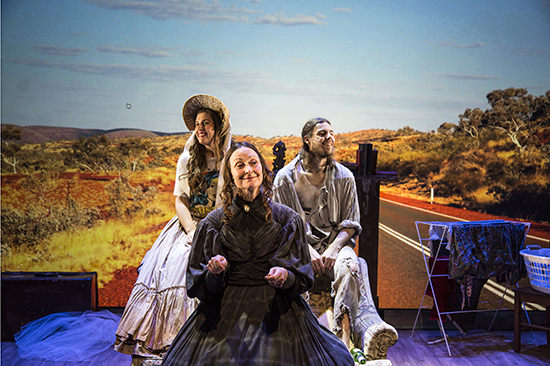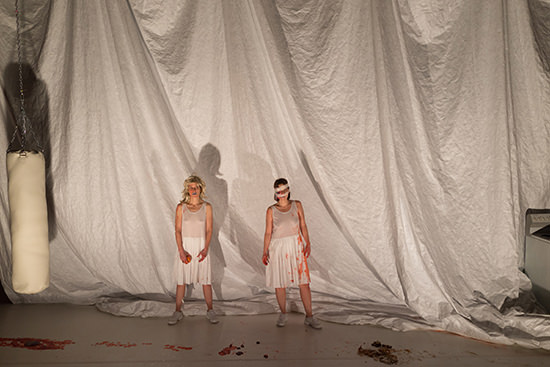The virtues of self-indulgence
John Bailey: Zoey Dawson, Conviction; THE RABBLE, Cain and Abel

Conviction, Zoey Dawson
To describe an artist as self-indulgent is one of the harshest forms of dismissal. Most other slurs are directed at the work itself: to decry its excessive length or muddled premise or cliches is only to criticise its maker in an indirect fashion. To call it self-indulgent, however, is to tie its faults back to those of its creator. It’s a self-reflexive criticism, of course. Pretty much all art involves the interests, obsessions or idiosyncracies of the artist. To label only some works ‘self-indulgent’ is to reveal that you don’t share those concerns or would never express them in such a way.
Zoey Dawson, Conviction
Zoey Dawson certainly isn’t the first artist to make a work about herself, but Conviction got me wondering whether self-indulgence can be a potent tool. I’d heard someone call the work self-indulgent prior to seeing it myself; thankfully this didn’t colour my experience, since one of the production’s many fascinations is its overt and explicit foregrounding of the very notion of self-indulgence.
The piece begins with a fairly overwrought scenario set in Australia’s convict days. A young woman and her mother attempt to establish their life in the colonies with the help of a handsome military officer and an earnest worker from the lower classes. There’s an overlay of unreality to it all, though, that goes beyond the slightly-too-loud sound design, the is-that-wall-swaying set and the occasionally ham-fisted performances. It’s almost a camp take on the colonial genre—and it bears obvious similarities to director Declan Greene’s outrageous burlesque on that genre, The Sovereign Wife (2013)—but at the same time it seems to be camping camp itself, denying us the twin comforts of knowing superiority and affectionate recognition afforded by camp in favour of radically destabilised viewing.
This becomes more literal as the young woman’s plight is infused with the problems of a middle-class 20-something today. Baulking at the idea of teaching (she’d have to work with orphans) or nursing (ditto sex workers) she decides to become a writer, that most selfish of roles. She drunkenly quizzes her mother before declaring the results: “You got Carrie Bradshaw!” and soon enough the artifice of her situation physically dissolves to leave her sucking bongs on a sharehouse couch in contemporary Australia.
Dawson’s program notes make it clear that an impulse to write a ‘proper’ play about important subjects such as women’s colonial experience was never going to entirely jibe with her own practice, and this work would be a mess if it simply ended in the playwright’s living room. It really just starts there, however, and the next hour torpedoes through kitchen sink realism, post-apocalyptic horror, adventure tale, meta-theatrical implosion and a recursive looping back to the work’s opening. And it’s all wonderfully self-indulgent.
Perhaps one of the funniest tiny details I’ve ever spotted in a live production comes when the wallpaper projected onto the set’s rear is replaced by a computer desktop and we see an image search for an Australian landscape bring up the autofilled text “Australia Council” for a fraction of a second. Of course a theatremaker’s browser has searched those words before. Why should that be omitted from this story?
Conviction doesn’t try to paint its writer in an attractive light—her self-absorption and inability to act ultimately leave her grizzling like a helpless baby in a nightmare deathscape. But that’s a depiction of the playwright’s avatar as much as any flattering fantasy would be, too. The question posed here is whether work that is unashamedly self-interested can be just as engaging as work that is more circumspect about the process. Rather than bringing everything back to Dawson in a solipsistic manner, Conviction presents an artist pulling herself apart at the seams, and it’s telling that its playwright, who seems so central to the production, is only actually present in it via a very brief, ironic and presumably prerecorded voiceover in its final moments.

Cain and Abel, The Rabble
THE RABBLE, Cain and Abel
It’s easy to imagine a newcomer to THE RABBLE’s work writing off its latest production, Cain and Abel, as self-indulgence taken to the extreme. Over the years the company has proven itself increasingly confident in erasing obvious appeals to the common denominators that usually signal ‘proper’ art. Its adaptations of classic literature can appear to bear no resemblance to their source, and aesthetic choices can seem based on a logic impenetrable to an outsider. Most absent is an authorial voice, something declaring ‘and this is why this work is important.’ With Cain and Abel, the results are electrifying.
Long-time RABBLE regulars Dana Miltins and Mary Helen Sassman respectively play the Biblical brothers of the work’s title. Cain kills Abel (spoiler) again and again in a succession of vignettes that evoke different associations. One draws on the realities of domestic violence as Miltins interrogates and murders Sassman over a stove; another conjures the abject violence meted out to women in cinema and television. The design is clinical and dazzling, the blood spatters and gore visceral in contrast.
Sex and gender are central here—two women are playing two men, but it’s unclear at what level, or if they’re ever, playing ‘men.’ On a surface level there are no reliable indicators of gender at all, even though they’re everywhere. Is that menstrual blood? Is the domestic abuser necessarily male? At the same time, the very fact that these roles are being enacted by women screams out for interpretation. Co-creators and company founders Kate Davis and Emma Valente produce particularly vicious scenes of butchery here, but it’s unmoored by anything approaching overt condemnation.
One possibility is that Cain and Abel requires that we fill the deliberate void of meaning it produces—that the audience is God, in a sense, making us at least in part responsible for the violence we’re witnessing (and the sacrifices we’re demanding). Another is that the audience is made conscious that theatre is not the communal sharing of space and time it’s so often touted as, but is just as much a fantasy of private voyeurism, that what we make of this work is finally saying something about ourselves.
I found yet another entry point in the way that ‘nature’ and the ‘natural’ were mentioned several times in the work: “It seems natural…” “Naturally…” The aesthetics of Cain and Abel are so heightened that these phrases stand out. What, in all of this, is natural? Is human violence natural? Is male violence, especially, somehow part of nature? By denaturalising this foundational myth, THE RABBLE make the constructedness of cultural assumptions on these matters more apparent, but by leaving open-ended the answers Cain and Abel puts our own complicity in determining them out there on the stage.
–
Darebin Arts Speakeasy & The Zoey Louise Moonbeam Dawson Shakespeare Company, Conviction, writer Zoey Dawson, director, dramaturg Declan Greene, performers Ruby Hughes, Caroline Lee, Dushan Phillips, Troy Reid, design Romanie Harper, lighting Amelia Lever-Davidson, sound design James Paul; Northcote Town Hall, 21 July-6 Aug; THE RABBLE, Cain and Abel, co-creators Kate Davis, Emma Valente, director, lighting, sound design Emma Valente, design Kate Davis, AV/video design Meg Wilson, Emma Valente, Kate Davis, performers Dana Miltins and Mary Helen Sassman; The Substation, Melbourne, 20-30 July
RealTime issue #134 Aug-Sept 2016






